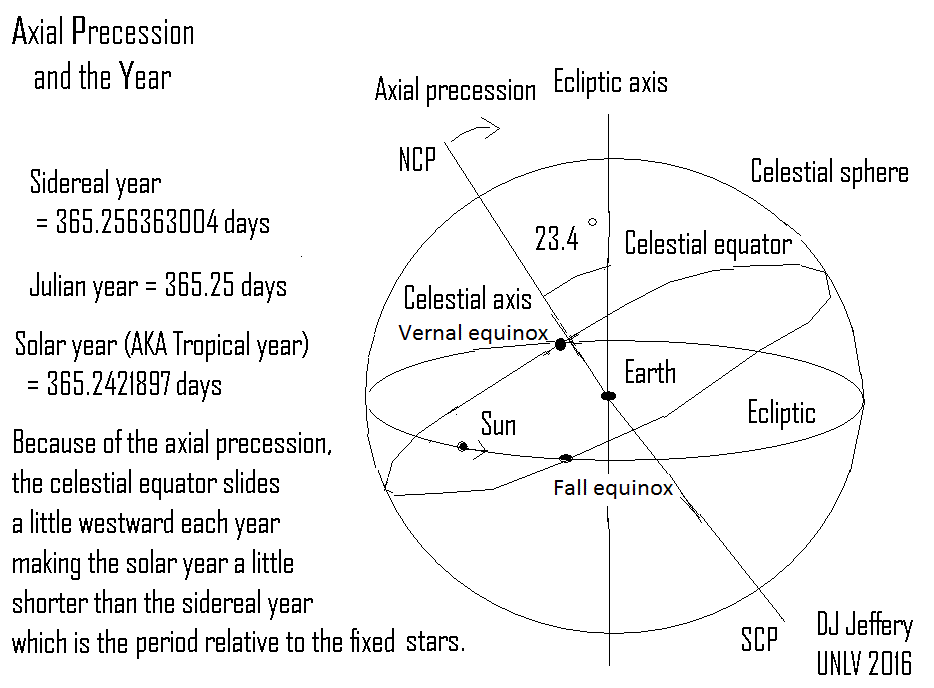
Caption: Because of the axial precession the solar year = 365.2421897 days (J2000) (which is the climatic year) is slightly shorter than the sidereal year = 365.256363004 days (J2000) (which is the physical orbital period of the Earth relative to the observable universe), and NEITHER are integer number of standard metric days of 86,400 seconds NOR exactly the Julian year (Jyr) = 365.25 days (exactly by definition).
Features:
- Note this
diagram
has the ecliptic axis
VERTICAL.
- The
axial tilt (currently 23.4°) of the
Earth is a tilt from the
ecliptic axis.
- There is an axial precession
of the Earth's axis with
a period of ∼ 26,000 Julian years (Jyr).
The
Julian year = 365.25 days exactly by definition.
There is no exact period since perturbations are always slightly varying the rate of axial precession in a way that CANNOT be accurately calculated over 26,000 Jyr.
The epoch J2000 rate is 1.396887832*10**(-2) degrees/year (see Wikipedia: Axial precession: Values). If this rate were constant, the period would be 25771.57534 Jyr.
- The cause of the axial precession
is the tidal force
of the
Sun,
Moon, and,
to a much lesser extent, the other
Solar-System bodies
on the Earth's rotational bulges
(see Wikipedia: Axial precession: Cause)
which are caused, of course, by
in turn are caused by the centrifugal force
of the Earth's axial rotation.
- The axial precession
itself is a sweeping out of a
double-cone
by the Earth's axis.
The direction is westward or, as viewed from the north celestial pole (NCP), clockwise.
- The celestial equator---which is, of course,
set by the Earth's axis---sweeps around
with axial precession.
- As the image shows, the motion of the
celestial equator causes a continuous
motion westward of the
vernal equinox
and
fall equinox (which is shown
most clearly).
Because of this westward motion
of the equinoxes, the
axial precession was
historically called the
precession of the equinoxes.
Thus, the Sun on the celestial sphere returns to the vernal equinox in slightly less time than the sidereal year = 365.256363004 days (J2000) (which is the physical orbital period of the Earth relative to the observable universe)---and, from the geocentric perspective, the period of the Sun to return to the same place on the sky relative to the fixed stars.
The time period from vernal equinox to vernal equinox is, of course, the solar year (AKA tropical year) which is the climatic year: i.e., year of the Earth's seasons.
Note on the vernal equinox, the Sun stands at zenith at solar noon---and so an actual observable event happens on vernal equinox.
- By the by,
since the equatorial coordinate system
is fixed by the
Earth's axis,
the axial precession
requires the
equatorial coordinates
for astronomical objects
to be continually updated for
high accuracy/precision aside from
any other causes for updates.
In the old days, this updating was a nuisance, but nowadays the computer does it without any problem.
Image link: Itself.
Local file: local link: axial_precession_year.html.
File: Celestial sphere file: axial_precession_year.html.